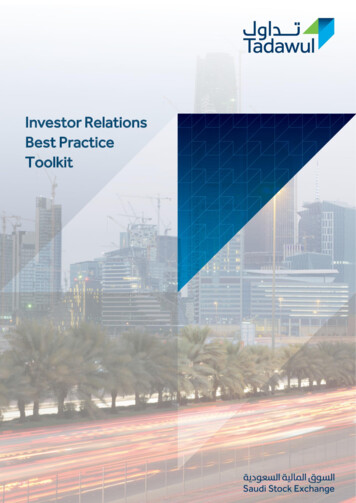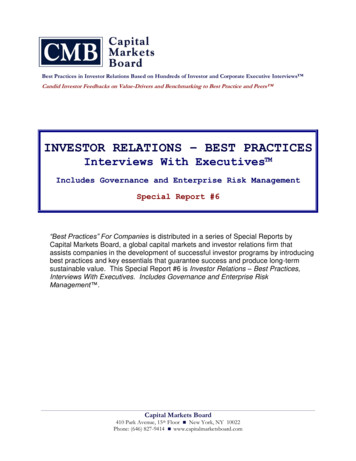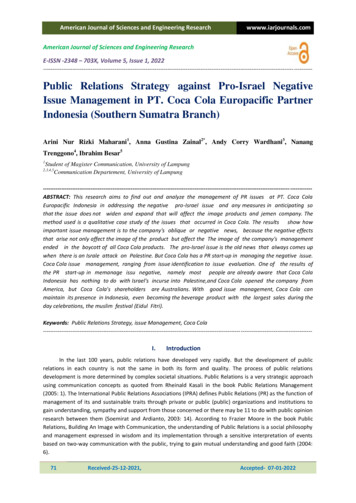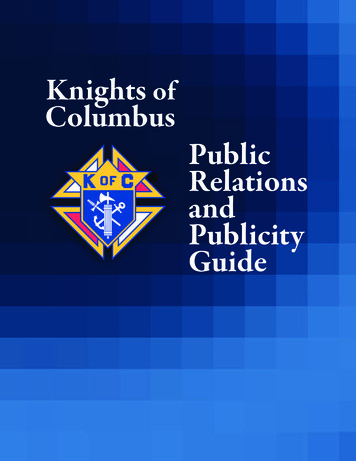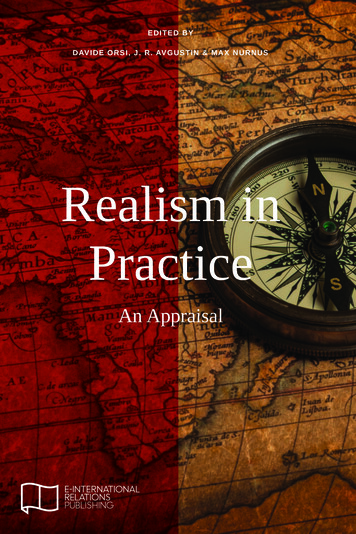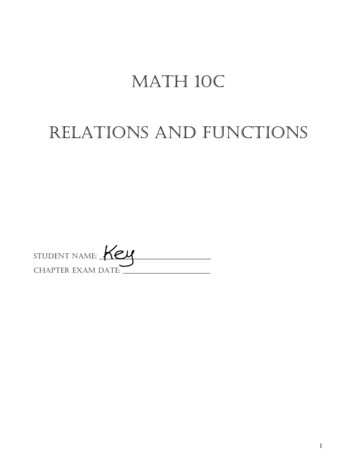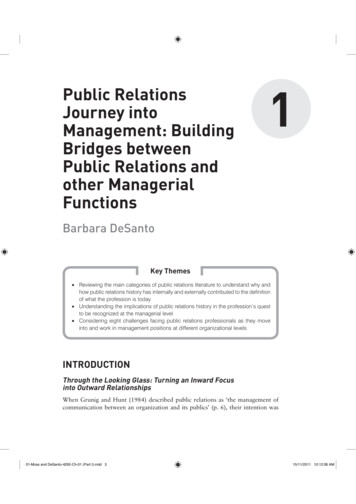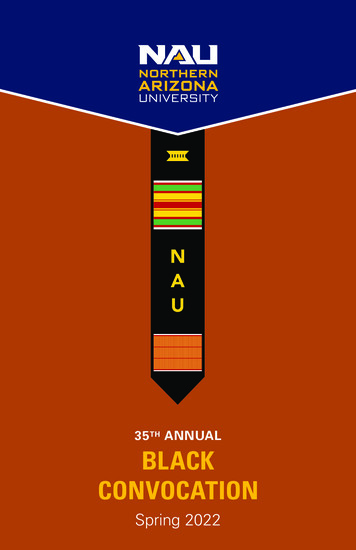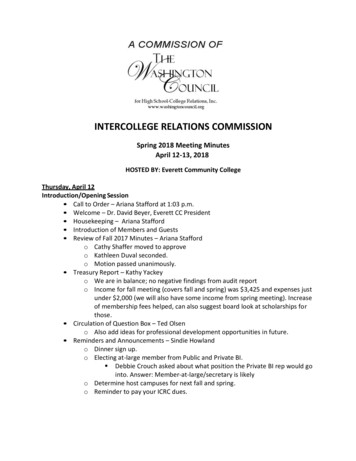
Transcription
INTERCOLLEGE RELATIONS COMMISSIONSpring 2018 Meeting MinutesApril 12-13, 2018HOSTED BY: Everett Community CollegeThursday, April 12Introduction/Opening Session Call to Order – Ariana Stafford at 1:03 p.m. Welcome – Dr. David Beyer, Everett CC President Housekeeping – Ariana Stafford Introduction of Members and Guests Review of Fall 2017 Minutes – Ariana Staffordo Cathy Shaffer moved to approveo Kathleen Duval seconded.o Motion passed unanimously. Treasury Report – Kathy Yackeyo We are in balance; no negative findings from audit reporto Income for fall meeting (covers fall and spring) was 3,425 and expenses justunder 2,000 (we will also have some income from spring meeting). Increaseof membership fees helped, can also suggest board look at scholarships forthose. Circulation of Question Box – Ted Olseno Also add ideas for professional development opportunities in future. Reminders and Announcements – Sindie Howlando Dinner sign up.o Electing at-large member from Public and Private BI. Debbie Crouch asked about what position the Private BI rep would gointo. Answer: Member-at-large/secretary is likelyo Determine host campuses for next fall and spring.o Reminder to pay your ICRC dues.
ICRC related Committee Reports Executive Committee Update – Ariana Staffordo Discussed option of considering host campuses not necessarily serving fullbreakfast.o Kathy Yackey: Is there a state rule about the amount? She will research to see.Cathy Shaffer: Not that I could recall.o Will continue to offer full breakfast moving forward at this time.oooooooooo Ongoing Articulation Review (OAR) Committee – Kirsten ClawsonFormer OAR Chair Megan Daniels is now at CWU and can no longer serve.Julie Garver will be transitions OAR chair.Reviewed Skagit, Olympic, and Shoreline this year.Finding questionnaire may be in need of modifications. Plan is to hold off ondoing reviews until after updating questionnaire this fall. Will notify schools thatare next in line of timing, and also look at what schools are coming up and whenwe will be reviewing.Plan to review and update overall mission of OAR. Not sure when last updated;likely has been some time to review.Considering changes of catalogs and supplemental information; hoping toexpand review to new technology that is being utilized by stakeholders.Would like to have a rep from the school being reviewed as part of the process.Has been useful in the past.Part of our current charge in reviewing the BIs. Process of course equivalencyguides.Will also look at adding more Major Related Programs (MRPs) for questionnaire.New public BI board member will be on OAR. Articulation and Transfer Council (ATC) – Kerrie Cavanesso Reviewing Smarter Balanced placement agreement.o Jim Brady: SBAC—CTCs are trying to salvage items. Joyce Hammer: SBCTC has anagreement in place that will expire soon. Julie Garver: Would like FAQ-typedocuments prepared later this spring; will continue to honor agreement for 11 thgrade assessment. Honoring those who took prior to January 1, 2018. Workingon finalizing policies for new assessment. SBAC draft reports indicates year tookthe test, which should help identifying. Our sector had small Ns (numbers ofstudents). She will share out info; hope to have finalized signatures later thisspring. Jim Brady: ATC may make recommendation in May and then have itmove up the chain to IC; hopeful by end of the academic year. Joyce Hammer:Adds that SBCTC interest is that our policy aligns with BI policy.o Kerrie: Working on brining accessibility into the classroom; workgroups alsomet.o Voted on HS 21 reciprocity agreement; affect CTCs.o Proposing changes to clean up AP equivalency documents.o Spring meeting at WWCC on May 10-11.
Washington Council for High School-College Relations (WCHSCR)– Ariana Staffordo Meeting held in February. Dates for fall counselor workshops in September areavailable online.o Transfer workshop at Green River Kent Station campus on Wednesday, August22.o Ensure schools have paid membership dues and to keep an eye out on newmembership requests.oooo ICRC Handbook Committee – Ted OlsenMember met this morning (Debbie Crouch, Keith Klauss, Cathy Shaffer, GailWootan, and Ted Olsen).Will adjust a few typos and also update constitution updates from fall meeting(treasury/tech position info).Waiting on membership regarding discussion about reciprocity for distributionfor credit policy (4.5 quarter example). Will this be a policy issue for JTC andhandbook or local (institutional) decision?Should we add an addendum to describe Common Course Numbering,particularly since career/technical course will be using it? More to come as thecareer/technical courses are reviewed for & usage.Agency Reports with Time for Discussion Council of Presidents (COP) – Julie Garvero Powerpoint link:https://www.washingtoncouncil.org/4.%202018 ICRC PPT details.CoP.pdfo Shaping her message with Avenger/Marvel themes based on son’s interest andrelevance to the work being done.o 2018 legislative session: A lot of players in higher ed really came together and didsome great things.o Huge investment in state need grant over the next few years; veteran funding;investment in key programs for BI programs; higher ed received good chunk offunding.o Quite a few bills passed for supplemental session.o Bills relevant: 2868: evaluate HS and beyond plan best practices; including BIs for“beyond” piece.o Biggest one around dual credit (SB 5917).o Transfer: Great example of how institutions have come together.o Reviewing pre-nursing; looking to expand for allied health careers.o JTC conducted first webinar in November 2017 with 150 attendees. Looking atdoing some more on key topics based on success.o All six BIs have reverse transfer articulation process in place.o Dual credit: It’s a great program and has taken a lot of time and energy on howto best communicate to stakeholders.o Working on sector statement for concurrent enrollment and college preparatoryprograms with exams.
o Worked with WSAC on process of sharing equivalency data.o Working on sector language for Cambridge A-Level exams.o Also looking at reviewing running start info; have received a number of questionsabout it lately. Want to engage and myth-bust dual credit with stakeholders.o SB 5917: This is setting up IB and Cambridge policy language. Requires that BIspost current policies; review AP/IB/Cambridge policies and report out why(evidence-based). IB/Cambridge for Nov. 1 2020; AP Nov. 1 2019. Will work toprovide updated reports every six months. It is a focus of the sector.o Keith Klauss: Question about requirements for BI and credit by exam scores. JulieGarver: AP scores of 3 required for elective at minimum; show why. IB:Demonstrate why we may or may not award for 4 on Higher Level or StandardLevel exams.o Institutions will share this info with COP, who will provide intermediate briefs tolegislative bodies. Envision a comprehensive report going back to legislature.Policy makers want to know the why and evidence-based information.o Gail Wootan: If not required to give credit for a 4 how would a school be out ofcompliance? Julie Garver: Out of compliance only if not providing evidence-basedinfo for the why. There’s a goal for clarity, not necessarily consistency, across thepublic BI sectors. Need to be clear and transparent to students and parents.o We have AP and IB charts currently, and they often naturally move to a moreconsistent but not required.o Joyce Hammer: For SBCTC sector we would have consistent policy across; we willbring in evidence to show why as well.o Julie Garver: We have sector-wide minimums that we have guaranteed for credit.Joyce Hammer: We also do that, but an example is AP English now requires a 4 atall institutions (some used to award English 101 for 3s). Jeanne Gaffney: Who iscurrently awarding for Standard Level? Julie Garver: Evergreen and CWU inlimited capacity. Joyce: Not many students in CTC sector have IB; we do havepolicies in place.o COP director meeting with K-12 staff to talk about variety of issues; hope directcommunication will help proactive solutions and progress. Working with CTCsabout BAS degrees. In WSAC’s Adult Student Re-engagement. Participate withWashington Council.ooooo State Board for Community & Technical Colleges (SBCTC) – JoyceHammerPresentation %20Spring%20Meeting%20SBCTC-2.pdfRole of transfer report (based on 2016 graduating class) will be posted soon.Working on getting final data for 2016-17 CTC transfers.WGU is picking up where University of Phoenix has dropped (relative to transfernumbers).Degree charts: AS-T degrees are moving up steadily. Chart shows all completions;so lower numbers for those that just started. Business-DTA/MRP is a goodexample of a solid MRP that is working really well. Pre-Nursing and Nursing are
oooooooooooogoing up. Will be looking at the engineering tech MRPs that are not beingutilized.Hot topics: AP chart; will work to clarify the language. Colleges can vary numberof credits only; adamant about minimum score. Dual credit: Joyce thinkslegislation is coming for college-level distribution credit (direct equivalencies) forall scores of 3. Engineering MRPs (WACERTE): Meeting in a couple weeks; this 2-4year group really helped get MRPs going. They want to stipulate what electivecredits are specified in MRP; will have to go through JTC. Also want to drop theword “pre.” Don’t want student to think it is a “less-than” path. Starting talksabout another MRP in material science and engineering composition. Hope tohave something in writing to show next fall.Guided pathways: Going ahead full bore; 12 colleges now have some funding forit. For transfer we need to be mindful of the MRPs and getting data to showeffectiveness. Way to make transfer-ready. Dream world: college meta majorsmatch MRPs that are in existence. It will take time because data for guidedpathways shows up in about five years. Those doing it now are showing greatprogress in closing equity gap.Reverse articulation: Speaker tomorrow from National Clearinghouse; they havebeefed up ability to help us with this. Share info to make this more seamless.New agreement are for direct transfer agreements; not workforce degrees.Benefit is for our students, and the CTC system also benefits from awardingtheses degrees.Interstate Passport: It’s the DTA and broken down into outcomes; other stateshave used this as a passport to transfer to schools in other states. Looking a pilotprogram at Walla Walla CC (they have students going to other states). WSU isalso in talks about partnering on this.Have groups that are working on math pathways; continuing process.Transfer and applicability issues group: Looking at data that shows the last mathcourses taken at CTC and what first class was taking at BI: how did they do andwhat happens with subsequent courses? Getting data to understand math-takingpatterns.Post-transfer institute: Action plan to minimize barriers. Challenge is we oftenhave to look back on students who earned bachelor’s degree and see where theycame from. Doesn’t tell us if students got into program they wanted to. Hope wecan do that sometime. A question Joyce would like addressed someday.Role of transfer report: Trends are staying pretty steady; looked at more than23k bachelor degree earners and looked backwards at where they came from.Did not separate running start students out of this. Psychology and business stillpre-dominantly transfer majors. Great to see AS-T degrees go into STEM degreeprograms. Still doing well in credit comparison of transfer to native students(citing median credits to degree). Keith Klauss: This is a reminder to all of us weare doing well as a state.Still working to continue on areas to improve transfer.Question: Issues or barriers to transfer: Jim Brady: 50% of SFCC transfer degreesearn bachelor’s. Non-associate degrees only 20%.Jennifer Coogan: Being pushed to award ACPL, but it’s limited to 15 credits in
transfer. Debbie Crouch: The handbook shows what the BIs agreed to at thattime. Joyce Hammer: Been very clear that 25% NWCCU standard is only portfolioreview. Jerad Sorber: Advisors running into their role for running start studentstrying to meet high school requirements. Trying to navigate HS gradrequirements that may conflict with intended transfer major requirements. JulieGarver: Example of rapid push toward dual credit hasn’t allowed time for thesetypes of policy documents (OSPI, etc.). Ariana Stafford: We do have K-12 repscoming tomorrow and will continue to plan to invite them to provide standingupdates.o Joyce Hammer: Looking at ways to get students in learning communities andintermediate algebra prep. Getting them to college-level in a year.oooo Joint Transfer Council (JTC) – Keith KlaussMet in November; preparing for legislation.Dual credit was a big topic; got to meet with College Board.Meeting April 23 and looking at MRPs; also what to do if an institution wants outof an agreement.Dual credit: pushing to have NACEP accreditation which would forego yearlyupdate for college in the high school review committee. Michael Meotti, Executive Director of WSACo Policy agenda for WSAC: It is all about state higher education policy; not all aboutone entity’s policy.o Council (WSAC) has done a lot of work with partners on goal for educationattainment for 25-40 year olds at 70% credential attainment. Current right around52%, so about an 18% gap.o Message that society needs to shift its vision that we need to get to much higherlevels of participation in education. Closing gap is an equity challenge.o Success is achieved on the ground; regional frames must be identified. Policy needsto understand those unique differences. Alignment opportunity and issues:understanding the population that will get us to 70% is aligning with resources thatare in place to support those with challenges outside of academic ones.o Returning adults will be a huge part of this goal. The core of state higher ed policy isit is a societal challenge and the best investment a community can make in itsfuture. Need more partners outside of educational sphere to make this work.Break at 3:31 p.m.Meeting resumed at 3:47 p.m. Agency Report: Washington Student Achievement Council (WSAC)– Gail Wootano Presentation link: AC.pdfo HB 1079 students get state need grant and will be eligible for college boundscholarship. More support for DACA and expired DACA students.o Working on student loan info and a formalized complaint portal for all students
ooooooooo(workforce included).Looking at getting web portal built to identify students to re-engage and connectthem to relevant resources (other state models: Indiana, Tennessee).Transfer: DTA/MRP reviews; we help convene workgroup. Business DTA wasupdated; very quick meeting with only one significant update in general electivearea.Pre-Nursing MRP up next; will be more complex. Sectors giving feedback.Working to identify what degrees this prepares students for. Could have severaltracks within it. Computer Science and Nursing MRP also upcoming.Kerrie Cavaness: Asked if dental hygiene, radiological science program, others attable? Joyce Hammer: Pre-nursing is still a transfer degree, so it will align withthose health academic fields. Cindy Mowry: The degree can help students takeprereqs and be eligible for financial aid grants. Debbie Crouch: Hope this updatecan help students identify other tracks beyond nursing. Gail Wootan: Hope thishelps students with that. Cathy Shaffer: Thankful this degree exists, use it forstudents to pursue a number of pathways.Computer Science provisos will be reviewed; understand there are a number ofthem.WSAC writes report every two years to legislature and it is meant to measurehow our MRPs are doing. How are these students doing relative to DTA anddirect-entry as related to earning a bachelor’s degree.Hoping to drill down on median credits earned for each MRP and relative tobachelor degree earned. Also look at student who intended to transfer; didthey? What % of students got a bachelor’s in same major area as two-yeardegree?Still trying to figure out which indicator is the best one to define a student’sintent. If they say they want to transfer to a 4-year degree, did they end up doingso. Jerad Sorber: A lot of pre-nursing students are intended to get an RN andusing that degree for prereqs. Would be good to look at including that as asuccessful transfer as well. Continued discussion about intent codes onadmissions applications.WSAC working to get data from ICW schools in addition to public schools. Mayhave some data to share by next fall’s ICRC meeting.Academic Credit for Prior Learning Discussion – Gail Wootan Washington StudentAchievement Councilo Presentation Link: WSAC.pdfo ACPL Handout ACPL.Handout.WSAC.pdfo Gail is current point of contact for ACPL. There is a workgroup that meets a coupletimes of year; not sure when next meeting is. Waiting to get full team again forplans on next meetings and workshops.o ACPL is not referencing AP/IB/Cambridge on WSAC’s definition.o 25% credit limit only applies to portfolio-based learning.o CTCs must denote source credit. Debbie Crouch: If automated electronic transcriptyou may have to look at back.
o Thankful for all data submitted by institutions for 2017 ACPL report. Most of creditcomes from Joint Services Transcript (military credit).o Question: DTA guidelines in ICRC handbook list 15 credits of ACPL (as defined in theHandbook) for the DTA degree.o Jeanne Gaffney: Gave policy example of WWU not awarding for CLEP and transferswith a DTA and 30 quarter credits. WWU doesn’t accept CLEP.o Emily Leggio: UW would apply own military credit policy.o Discussion regarding varying credit CTC/BI policies for awarding/accepting ACPL.Need to revisit 15 credits of restricted for ACPL toward DTA (pg. 36 of handbook)and that would need to be addressed by appropriate parties.o Definition of ACPL (posted on WSAC website LINK) comes from legislation. Morecollaboration likely needed with ACPL workgroup.Friday, April 13o Ariana Stafford called meeting to order at 8:33 a.m.o Introduction of Dion Yahoudy, Newport H.S. Bellevue district principal. Serve asKINGCO 4A principal. NHS does a lot with Bellevue College, wants to be proactivein identifying solutions. Wants to learn more from this system to take back to theschools and partners.o Housekeeping— Ariana Staffordo Circulate Question Box— Ted Olseno Announcements—Sindie Howland Will be voting on board members from private and public BIs and identifyinghosts from next fall and spring session.Call for Unfinished Business Covered update on K-12 representation with ICRC in theintroducation. ICRC Handbook Proviso updateso Continuing business. Goal of handbook committe is to make call for provisos atspring meeting each year. Get these to Cathy/Gail and then handbook group willreview and get them published by next spring in the handbook. Common Course Numbering progresso Where are we at with prof/tech process? Joyce Hammer: We don’t have any thathave come forward at this time. Working with ATC and workforce council. There aresome already in early childhood education and aviation as examples. Those wereapproved through ATC.o Ted Olsen: The process is in motion and will be some time before it plays out; Joyceconcurs.
Distribution Requirementso Debbie Crouch: Conversation about 3 semester credit transferring into 4.5 quartercredits to fulfill a distribution area; how does it count toward broader 60 creditdistribution area? Group discussion: The understanding has been always been a localcontrol, but don’t want student caught in the middle without knowing for sure. Onethought was if ok if the 60 credit area is met. Cathy Shaffer: Talked about adding anote to ICRC handbook as a note for guidance. Want to maintain historicalperspective, especially for new people. Ted Olsen: Adding more as an appendix forguidance. Emily Leggio: Suggested having an FAQ area on the website. Ted Olsen: Ifwe solidify it, would need to go through JTC. Jerad Sorber: See this quite a bitbecause of Oregon 4 quarter credit classes, and with students reverse transferringfrom WSU (semester-based). If we can’t write it into DTA requirements, would liketo see it potentially go through policy (JTC, etc.) so it doesn’t continue to rear itshead. Keith Klauss: Concern we have is may be challenging to find precise policylanguage because of variables. Could be challenging to make a policy for all. Doinghandshake agreement now. Gail Wootan: There is an FAQ created in 2009; we willwork to post online. Jerad Sorber: We may end up in some weird areas but we reallyneed to do something because this is a continuing issues. Ted Olsen: If we arearriving at solutions even if it is uncomfortable, are we in need of hammering out aspecific policy? Gail Wootan: Think it falls under check with your school. WaylonSafranski: WSU has policies in place to accommodate for quarter transfer courses(below 5 credits) and application toward satisfaction of our general educationrequirements provided a baseline total is met. With th reverse transfer emphasisacross the state, this issue will not slow down for the CTCs. Ted Olsen: Are we at aplace where we should vote? Jennifer Coogan: Would like best practices on this;deans are asking. Ted Olsen: Suggest to work to put together best practices in thenext year. Joyce Hammer: Please loop ARC in that is what we refer to when we getthese types of questions. Waylon Safranski: How do 300-level gen ed coursestransfer from BI to CTC for DTA distribution? WSU has numerous gen ed courses atthat level. Joyce Hammer: This is an exception to local decision; we want it to be fairto Joyce: There is policy to share 300-level courses from CTC to be used on DTA.Ariana Stafford: We (EvCC) won’t use 300-level equivalents. (Ammended in 8/18 tosay EvCC will use 300-level BI gen ed course for DTA distribution. Waylon Safranski:We will work to get the BI recriprocity agreement Joyce Hammer has shared with meposted online for all to see. The Academic Credit for Prior Learning and DTA Restricted Listtopic was covered Thursday afternoon.
ooooooNew Business Select new ICRC Executive Board member-at-large from public andprivate BIsCindy Mowry moved to nominate Debbie Crouch (SPU) as 2-year private BI ICRCboard member with the role of Chair for 2018-19 and Past President for 2019-20.Jennifer Coogan seconded.Motion passed unanimously.Cathy Shaffer moved to nominate Carlos Cavillo (EWU) as public BI ICRC boardmember-at-large.Julie Garver secondedMotion passed unanimously. Washington 45 course reviewo Joyce Hammer: It is a list of courses that transfer to all schools. It is not reallyupdated a lot, but it is used a lot by the high school counselors. Worries me becausethere are a lot of great classes on it, but it needs to be reviewed to ensuretransferability across the distibution for general education. Would like to discuss thelist. Jeanne Gaffney: If you (CTCs) have a list of courses you can send out to BIs. JeradSorber described that process. Julie Garver: Would like to take this to dual creditconversations. Washington 45s can ensure these courses will transfer. WaylonSafranski: Very hard to advise just from the list because it does not aling with specificgen ed patterns and/or major requirements. Joyce Hammer: We are aware of the listand how it is used and think to add clarity to message in how they transfer tointended pathways. Jim Brady: Need clarity for the package. CCN is designed for CTCto CTC transfer. In Spokane we did not buy in fully. Clarifying note for WA 45 list:Could update BIs by distribution area? Joyce Hammer: Can get the spreadsheet ofcourses updated. Share out of how ASL is accepted at BIso Gonzaga doesn’t accept as foreign language; gives elective credit. WWU accepts aselective but they do not have a foreign language requirement. Emerging issues/topics for future meetingso Jennifer Coogan would like to see more ACPL discussion and progress on policy. GailWootan: QSR part of DTA, intermediate algebra. How are people interpreting that?Ariana Stafford: You can also send these to us for fall. Select fall and spring meeting location and dateso October 11-12: Clark College; UW Tacoma as backup.o April 11-12: Central Washington University.BI Updates and Q/Ao Rose Spodobalski-Brower: CWU is changing general education list drastically. Willstill accept DTA of course and most WA 45. Michael Blankenship: WSU Vancouver:Data Analytics degree offered in fall; will be adding life sciences. Debbie Crouch: SPU
will have a new mechanical engineering and other related degree programs. JeanneGaffney: WWU offer bachelor’s in business and sustainability. Keith Klauss (EWU):Initiatives alternate route for education for teacher. Catalyst program partnershipwith Avista Corporation. Moving programs to Spokane building engineering andcomputer science, visual communication. Very excited about the programs. EmilyLeggio: UW changes in admissions to engineering area; biggest change is freshmanadmission. Don’t see much of an effect on transfer. Some deadlines are moving. Goalto get transfer student admissions by department to earlier in the process (beforesummer). Kathy Yackey: City Univ: Working to move from college math to QSR-typerequirement. Ted Olsen (UW Tacoma): Programs moving to a schools model. Somenew permanent leadership recently. Waylon Safranski (WSU): New WSU EverettOrganic Ag degree program. A few new programs at WSU Global Campus (online).Had NWCCU accreditation visit earlier this week. College of Business looking toupdate curriculum; nothing finalized yet, timing of earlier certification and directtransfer guarantees being looked at.Break at 9:40 a.m.Meeting resumed at 10:01 a.m.-National Student Clearinghouse (NSC) – Dannette Sullivan and Michelle Blackwell.Presentation sfer.ICRC.Blackwell.418.pdfo Every school in this room is a member of NSC; send us enrollment data to complyand Title IV aid. Started out to help report info, through years helped schools withother needs. Recently schools came to us regarding issue of reverse transfer.Michelle has worked with many other states in setting this up. Did reverse transfer inNorth Carolina statewide (58 CCs and 16 universities)o Student mobility: Cited student data regarding many students attending more thanone school. 66% of students transfer before earning an associate’s degree nationally.o States data to show effect of reverse transfer: Retention and bachelor’s degreecompletion went up across the states. Seeing in research that reverse transfer ismaking a difference. UTEP & El Paso CC had 84% completed bachelor’s degrees.o Incentivizes students, provides a milestone, goal achievement, feeling ofaccomplishment, and positive moment toward bachelor’s.o Research showed students who get the associate’s degree increased income.o Clearinghouse can work on solutions that may even cross state lines in transfer.Looking at national solutions. 25% of transfer students move between state lines.Really think this can make a big difference for military population.o Potential completers in Washington: 84% of 73,000 who started in Washingtonstayed in WA. Showed other states in the west where students go and multi-statewas next highest. Also showed 8,000 students who transferred into Washington andhad potential for reverse transfer.o How does NSC process work: 4-year gets FERPA release, 4-years pull file of alleligible students, what credits earned, where they attended and send to NCH. Thensend to two-year schools to determine applicability toward degree requirements.
oooooooooWhen 4-years give us data we send it to every institution in the country. Ex. Univ. ofAlabama students getting reverse transfer degrees in Iowa. Very broad reach.File process is a pipe delimited file, working on EDI and XML files soon.Includes central location to store, crosses public/private and state lines, free andunlimited course and grade data exchange, ability for host to send all reversetransfer date in one file submission. Degree-granting institution ability to downloadtheir date from host institution in one place.Increase data quality, current student contact information ensure diplomas for twoyear sent to right address, searchable by student, reports for both sides to tracknumber of degree, identification of courses as core/gen ed courses. Also filter forassociate degrees before sending to 2 year institutions. Download data when the 2year is ready to evaluate for the semester and receive student data when based on athreshold of total earned hours. Institutions can set hours so two-year can filter byamount of credits when ready to evaluate for two-year degree (timing).Ability to send/receive at state/system level; robust implementation guide included.Data fields based on advisory board that are required and optional. Encourage 4year institutions to submit as much as possible.File submission validation occurs and reports are sent to assist institutions with theprocess.Questions: FERPA release in state of Washington? Best practices; recommend 4-yearinstitution gets that release. Most effective way to get the release is on theadmissions application. Don’t like to use opt-in or opt-out. Can put the informationon the application, say yes or no, could default to yes and students can update to no.Would need to put it on freshman apps for those with dual credit. Another way is a“pop up” in student portal; can add as a FERPA release if they have transfer credit viaa CC. Some may also use third-party CRM. The more automated the FERPA release isthe higher your return will be. There is some legislation at national level for reversetransfer; could potenti
o Reviewing pre-nursing; looking to expand for allied health careers. o JTC conducted first webinar in November 2017 with 150 attendees. Looking at doing some more on key topics based on success. o All six BIs have reverse transfer articulation process in place. o Dual credit: It's a great program and has taken a lot of time and energy on how
